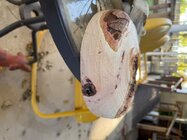-
November 2025 Turning Challenge: Wall Hanging! (click here for details) -
Sign up for the 2025 AAW Forum Holiday Swap by Monday, November 24th (click here for details) -
Congratulations to Konstantin Gusev for "The Nutcracker" being selected as Turning of the Week for November 17, 2025 (click here for details) -
Welcome new registering member. Your username must be your real First and Last name (for example: John Doe). "Screen names" and "handles" are not allowed and your registration will be deleted if you don't use your real name. Also, do not use all caps nor all lower case.
You are using an out of date browser. It may not display this or other websites correctly.
You should upgrade or use an alternative browser.
You should upgrade or use an alternative browser.
Plastic for resin pouring
- Thread starter Kennith Gosnell
- Start date
Are you asking what the best resin would be, or what container to use for holding it all while it cures?What is the best type/brand of plastic to use for pouring resin around bowl blanks like the ones pictured? I have a vacuum chamber to put in after pouring just not sure about what would be best to create the mold.
If you're talking about curing the resin, you want it under pressure to reduce or eliminate air bubbles. Vacuum is would make bubbles larger and/or more numerous.
Are you asking what the best resin would be, or what container to use for holding it all while it cures?
To hold it in while it cures. I keep seeing people making their own cylinders out of plastic sheets. I do have some silicone molds but they are not big enough and the bigger ones are really expensive. Just suffered a job loss so until i get something else i dont want to spend the money.
You should check out the difference between stabilizing and casting with resin. As Darryl mentions, casting resin is normally used with a pressure pot, while stabilizing is usually done with a vacuum. The two processes use different synthetic materials as well. Since the stuff is pretty expensive, until you're more cash flush, you don't want to use the wrong stuff and waste it.
Are you asking what the best resin would be, or what container to use for holding it all
Hi Kennith, I’ve been wondering the same thing. I found this on YouTube which I’m going to try. I ordered some plastic kitchen cutting mats from amazon that will do the trick I think.What is the best type/brand of plastic to use for pouring resin around bowl blanks like the ones pictured? I have a vacuum chamber to put in after pouring just not sure about what would be best to create the mold.
A guy at our local club buys the cheap plastic serving bowls from the dollar store and uses those.
I thought of that. Went there yesterday couldn’t find a size I needed. The problem for me is I use way more resin than needed to cover the piece of wood to just turn all awayA guy at our local club buys the cheap plastic serving bowls from the dollar store and uses those.
I do have another method, which you probably won’t like! I’m a segmenter, so I have made segmented inner and outer walls out of cheaper lumber ( poplar) and used those to create the mold. You can make them to the exact size you want and minimize resin waste. They then get turned away on the lathe. A great segue into segmenting 
If you're talking about curing the resin, you want it under pressure to reduce or eliminate air bubbles. Vacuum is would make bubbles larger and/or more numerous.
Curious about this, having never used resins. How viscous is the resin and how long does it takes to cure?
When I ran a metallography lab I used epoxy to pot small bundles thin plates cut from nuclear reactor elements for polishing and analysis. Put the bundle in a simple mold and filled with epoxy and put the sample under vacuum during curing.
By using vacuum the bubbles expanded and bubbled to the top of surface of the epoxy mixture, ground away after the epoxy set up.
Under positive pressure the air bubbles remained between the plates in the bundle, just got smaller and could hold unwanted grit at polishing stage.
The vacuum method was easier since a simple plastic dome over the sample set simple flat base. (The hemispherical dome was inherently strong due to the shape and self-sealed under vacuum. Using positive pressure would have required a stron pressure pot with means to clamp the lid and a good seal.
I'm wondering - if using pressure are the reduced-size air bubbles still visible with a sufficiently clear resin or are the bubbles so tiny to be invisible or get forced into the wood? Or maybe the resins are not transparent enough. Or maybe the resin is too viscous for the air bubbles to come to the surface. ???
BTW, I found an industrial stainless steel pressure pot in good condition at a local metals recycling place. They sell everything at scrap metal prices. Fun place to browse.
JKJ
In a perfect world, you would likely want to use vacuum to degas the resin before pouring. Then pressure after the pour. If your mold is bowl shaped, bubbles can just get trapped in the more horizontal sections and not escape - so vacuum can make the situation worse by making the bubbles bigger. The pressure just reduces any bubbles to so small they are hard to see, but it will work on trapped bubbles too.


